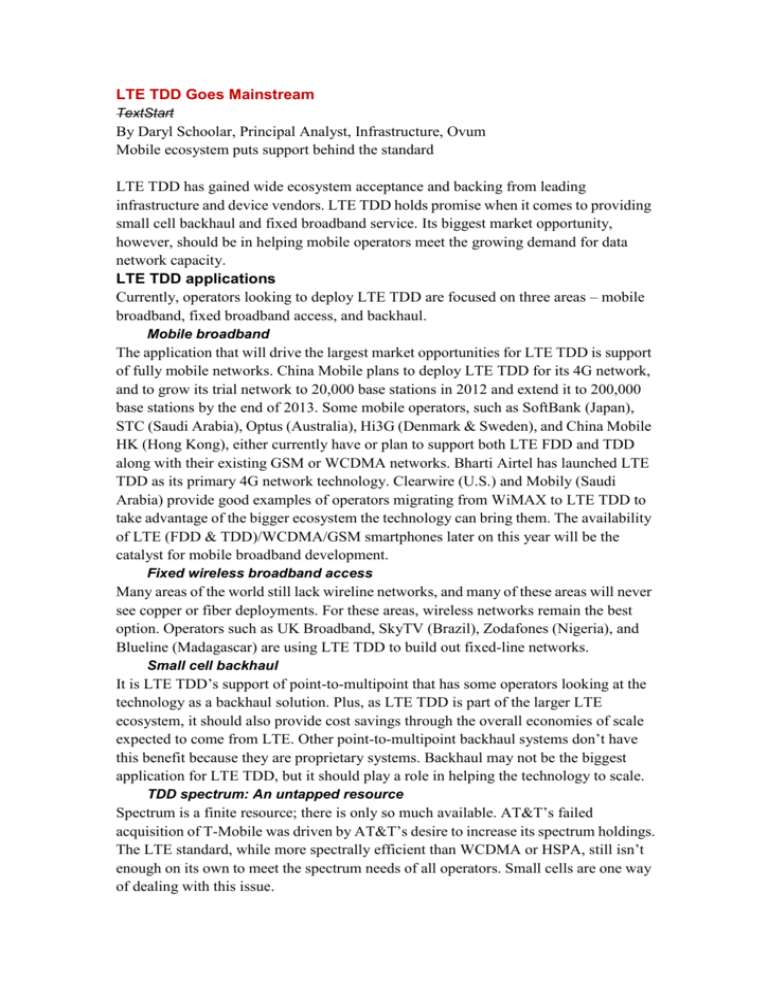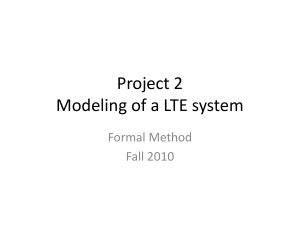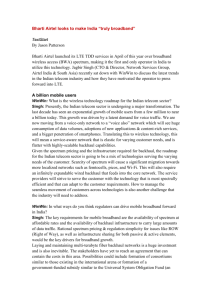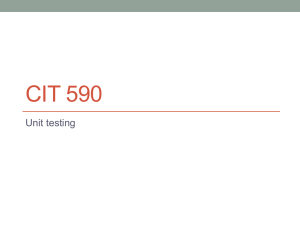LTE TDD Goes Mainstream TextStart By Daryl Schoolar, Principal
advertisement

LTE TDD Goes Mainstream TextStart By Daryl Schoolar, Principal Analyst, Infrastructure, Ovum Mobile ecosystem puts support behind the standard LTE TDD has gained wide ecosystem acceptance and backing from leading infrastructure and device vendors. LTE TDD holds promise when it comes to providing small cell backhaul and fixed broadband service. Its biggest market opportunity, however, should be in helping mobile operators meet the growing demand for data network capacity. LTE TDD applications Currently, operators looking to deploy LTE TDD are focused on three areas – mobile broadband, fixed broadband access, and backhaul. Mobile broadband The application that will drive the largest market opportunities for LTE TDD is support of fully mobile networks. China Mobile plans to deploy LTE TDD for its 4G network, and to grow its trial network to 20,000 base stations in 2012 and extend it to 200,000 base stations by the end of 2013. Some mobile operators, such as SoftBank (Japan), STC (Saudi Arabia), Optus (Australia), Hi3G (Denmark & Sweden), and China Mobile HK (Hong Kong), either currently have or plan to support both LTE FDD and TDD along with their existing GSM or WCDMA networks. Bharti Airtel has launched LTE TDD as its primary 4G network technology. Clearwire (U.S.) and Mobily (Saudi Arabia) provide good examples of operators migrating from WiMAX to LTE TDD to take advantage of the bigger ecosystem the technology can bring them. The availability of LTE (FDD & TDD)/WCDMA/GSM smartphones later on this year will be the catalyst for mobile broadband development. Fixed wireless broadband access Many areas of the world still lack wireline networks, and many of these areas will never see copper or fiber deployments. For these areas, wireless networks remain the best option. Operators such as UK Broadband, SkyTV (Brazil), Zodafones (Nigeria), and Blueline (Madagascar) are using LTE TDD to build out fixed-line networks. Small cell backhaul It is LTE TDD’s support of point-to-multipoint that has some operators looking at the technology as a backhaul solution. Plus, as LTE TDD is part of the larger LTE ecosystem, it should also provide cost savings through the overall economies of scale expected to come from LTE. Other point-to-multipoint backhaul systems don’t have this benefit because they are proprietary systems. Backhaul may not be the biggest application for LTE TDD, but it should play a role in helping the technology to scale. TDD spectrum: An untapped resource Spectrum is a finite resource; there is only so much available. AT&T’s failed acquisition of T-Mobile was driven by AT&T’s desire to increase its spectrum holdings. The LTE standard, while more spectrally efficient than WCDMA or HSPA, still isn’t enough on its own to meet the spectrum needs of all operators. Small cells are one way of dealing with this issue. Small cells help operators deal with spectrum limitations through carrier Wi-Fi solutions and through increased spectrum reuse with pico- and microcells using licensed spectrum. The most obvious method for an operator to expand its spectrum position is through the acquisition of more FDD spectrum. This, however, is not always that easy. Government regulators, as in the case of AT&T and T-Mobile, may block the deal. Purchasing spectrum at an auction may not always be an option because of either the cost or the availability. Another option, and one more operators are looking at, is deploying LTE TDD over unpaired spectrum. Mobile operators can deploy a multi-mode LTE network to increase their overall network capacity. LTE TDD can be deployed in dense metro areas to provide capacity injection into areas where the LTE FDD network is strained. Part of the capacity benefits LTE TDD bring comes in the size of available spectrum blocks. Unpaired or TDD spectrum bands often come in large blocks. It isn’t unusual to see TDD spectrum auctioned off in 30MHz slices. From a capacity perspective, this is an advantage over the typical 2x10MHz configuration found in FDD spectrum. LTE Release 8 has a theoretical maximum speed of 16bps per hertz; the more hertz an operator has, the faster the network. TDD spectrum costs much less The biggest advantage of TDD over FDD spectrum is its cost. Mobile operators have historically been able to purchase TDD spectrum at a lower price than FDD. This has primarily been due to the fact that mobile operators have had limited options for using TDD spectrum. Until now, many of the systems that were available for TDD spectrum were proprietary, and not part of a larger ecosystem. Even with lower spectrum costs, the proprietary nature of those network systems that used unpaired spectrum have limited operators’ interest in networks using TDD. LTE TDD is changing that. With LTE TDD, operators can use lower cost unpaired spectrum with a networking technology that is part of a larger ecosystem than that for paired spectrum. This makes the overall cost of the network lower than those using paired spectrum. From a competitive position, this lower cost can make it easier for an operator to rollout a network and achieve a return on its investment. It can also use the lower cost of network ownership to offer lower-priced service and gain a competitive advantage in the market. However, mobile operators do need to be aware that the current spectrum cost advantage may not last. As interest in LTE TDD increases, so too, most likely, will the cost of unpaired spectrum. LTE FDD spectrum challenges Despite the popularity of FDD spectrum, it comes with many challenges. One of those challenges is that unused spectrum suitable for LTE FDD may not be readily available. In the U.S. there are ongoing LTE FDD deployments in 700MHz. This spectrum band’s propagation characteristics provide good coverage over large geographic areas. However, 700MHz is not readily available in all markets. In some markets, TV signals still transmit over the 700MHz band. It will take time for those bands to be cleared out and made available for mobile communications. Competition for FDD frequency brings its own problems as well. The most obvious problem competition brings to FDD spectrum is cost. As has been discussed already, bidding on prime FDD spectrum can be expensive due to high levels of competition for that spectrum. Competition for that spectrum can also lead to it being divided up into small allotments among multiple operators. These allotments can be small in size in terms of MHz or geographic coverage. In either case this will make it difficult for an operator to be successful. Another solution for gaining FDD spectrum comes from refarming. With spectrum refarming, an operator uses existing 2G and 3G spectrum for LTE FDD. There has been significant interest in using 1800MHz for this. The problem here is that spectrum refarming can take a long time to achieve, slowing down the deployment of LTE. Because of these different challenges with FDD spectrum, the interest in TDD has risen. LTE TDD has broad support Global interest As discussed previously, one of the factors in LTE TDD’s success has been the fact that it has grown beyond just being a ‘China-only’ technology. Ovum has identified 45 LTE TDD network commitments, only one of which has been made by China Mobile. It is also worth noting that the first commercial LTE TDD networks did not come from China, but from operators in Japan, Europe, and the Middle East. As shown in Figure 1, the global distribution of LTE TDD network commitments will help the technology to grow. It provides reassurance that deployment won’t be dominated by one country. In fact, the size of the Softbank deployment in Japan could make it the largest LTE TDD deployment until China Mobile goes commercial. In terms of just numbers of deployments, India appears to be well ahead of China, with seven different Indian operators committed to the technology. Strong device support Strong device support and wireless technology adoption are very much related. Without strong device support, end users will not adopt a technology. In this regard, LTE TDD appears to have a bright future. Chipset and device vendors have come out in support of the technology. Mobile operators should not be worried that deploying LTE TDD will limit their device choices. Multi-mode LTE FDD & TDD is promising Even more promising than just broad LTE TDD support is the support for multi-mode LTE FDD and TDD devices. Devices that support both types of LTE will help drive up device volumes, which will bring prices down, and allow for roaming between FDD and TDD LTE networks. Chipset vendor Qualcomm, for example, markets a chip that supports both FDD and TDD LTE. These chipsets are also multi-standard with GSM, WCDMA/HSPA, and CDMA support. Multi-standard support is very important, as there will be very little interest in devices that support just LTE TDD within the mobile operator community. Hisilicon, which has multi-mode and multi-band chipsets, already supports category-4 LTE TDD chipsets with 150Mbps in the downlink. On the device front, Huawei introduced the world’s first multi-mode personal hotspot device in December 2011 and a category-4 version will be available soon. Other multi-mode chipsets and devices are expected to follow from other vendors. LTE TDD commitments coming from leading operators in Brazil, Russia, India, and China will generate the scale needed to sustain long-term multi-mode device development. 25% of LTE connections by 2016 LTE connections can be segmented into three categories – FDD, TDD, and FDD/TDD. Of the three categories, LTE FDD has been more widely deployed and adopted. LTE FDD’s greater number of connections, versus those that involve TDD, can be attributed to two things. First has been the historical trend of most mobile operators preferring FDD spectrum over TDD spectrum. The second comes from LTE FDD’s initial commercial deployments coming in 2009, versus LTE TDD’s coming in 2011. Figure 2 shows Ovum’s forecast for LTE connections that are only FDD, TDD, or a combination of FDD and TDD. Despite the head start LTE FDD has over TDD, LTE connections using TDD will account for a significant percent of all LTE connections by the end of 2016. Ovum estimates that around 25% of all LTE connections will either be purely TDD or a combination of FDD and TDD at that time. Of the two, connections that are primarily TDD will account for the majority of those connections. Most mobile operators for the near to midterm will opt for either FDD or TDD in their existing network, not both. Infrastructure support is key Infrastructure vendor support is just as important as that of the chipset and device community when it comes to the long-term success of LTE TDD. Networks are a major investment by mobile operators. Service providers want assurance that the infrastructure community shares their commitment to a technology before deploying it. LTE TDD has support from all the leading infrastructure vendors. In fact, their LTE FDD solutions also support TDD. This allows them to provide operators with a choice between types of LTE along with the option of deploying both. Market leadership involves many factors Deploying a network can be a major undertaking that costs millions, if not billions, of dollars. Selecting a network partner is not something operators take lightly. The infrastructure partner plays a major role in the success of the network. That is why a thorough understanding of how different vendors stack up in terms of market leadership is important. It gives mobile operators much needed insight to help guide them in picking their network partners. One of the most obvious ways to judge market leadership of vendors enabling the underlying infrastructure is to measure equipment shipments. But shipments, especially in the early stage of a market, can be misleading when it comes to true market leadership. A vendor successfully landing one or two early deployments could be a market share leader in the short term, but that position may not hold for the long term. When looking at market leadership in the early stages of a market, other factors beyond market share need to be examined. For LTE TDD, Ovum has identified the following factors when it comes to judging market leadership: LTE TDD commercial wins – While market share shouldn’t be the only indicator of market leadership, a vendor’s ability to win LTE TDD deployments certainly remains an important indicator of market leadership. Commercial wins provide an indicator of the vendor’s ability to sell its LTE TDD solution to operators. It also provides when it comes to operators’ acceptance of that vendor as a network partner. Combined LTE commercial wins – Like LTE TDD commercial wins, success in selling LTE FDD is another important indicator of operators’ perceptions of the as a network partner and the quality of the vendor’s network solutions. Furthermore, mobile operators add LTE TDD to their existing LTE FDD networks, success in gaining those initial LTE FDD wins provides a good indicator of who will win the TDD deployment, especially as those LTE FDD networks also support the TDD variant. GSM/WCDMA/HSPA market share/experience – A vendor’s previous success in gaining GSM and WCDMA/HSPA market share will impact their success in winning LTE deployments. Vendors have seeded the market for some years with multi-mode base stations. Those base stations help ease some of the pain that operators will face they transition from 3G to LTE. Being the incumbent 2G or 3G vendor certainly gives that company an advantage when the mobile operator starts to look for LTE network partners. Furthermore, 2G and 3G success gives vendors credibility with mobile operators in terms of technology development and their ability to support network rollouts. Unpaired spectrum experience – Prior to LTE TDD, the most common network technologies to use unpaired spectrum were TD-SCDMA and WiMAX. Experience in deploying these technologies gives infrastructure vendors important experience in deploying networks that use time division duplexing. Not to be overlooked is the with WiMAX operators like Clearwire (U.S.) and Mobily (Saudi Arabia) to deploy LTE TDD. Having a WiMAX customer base gives vendors increased sales prospects for their LTE TDD gear. LTE TDD device support – End-to-end LTE network support is common with the major infrastructure vendors. All of them can deliver base stations, backhaul, and packet core solutions to operators. But, device support can be a real differentiator for vendor, especially in the market’s early days when device availability can be limited. Being able to deliver devices, along with infrastructure, can ensure that operators can sell services on their new network. Having control of chipset development also helps here. 2G/3G leaders should dominate LTE TDD For 2011, Ovum estimates that Ericsson, Huawei, and Nokia Siemens Networks generated over 70% of global base station revenues. This includes revenues for all the major wireless standards – GSM, WCDMA/HSPA, LTE, CDMA, and WiMAX. Because of these vendors’ existing mobile infrastructure positions, they should be in the best position to capitalize on LTE TDD in the long run. Please see Figure 1 in PDF Please see Figure 2 in PDF TextEnd





